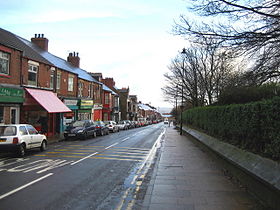Easington Colliery
| Easington Colliery | ||
 Crédit image: Chris Heaton licence CC BY-SA 2.0 🛈 Seaside Lane | ||
| Administration | ||
|---|---|---|
| Pays | ||
| Nation | ||
| Comté | Durham | |
| Force de police | Durham | |
| Incendie | County Durham and Darlington | |
| Ambulance | North East | |
| Code postal | SR8 3 | |
| Démographie | ||
| Population | 5 022 hab. (2011) | |
| Géographie | ||
| Coordonnées | 54° 47′ 13″ nord, 1° 19′ 45″ ouest | |
| Localisation | ||
| Géolocalisation sur la carte : Royaume-Uni
| ||
Easington Colliery est une ville anglaise située dans le comté de Durham, au nord-est du pays. En 2011, sa population était de 5 022 habitants[1].
Easington Colliery, was one of the most modern and productive mines in Europe but at 4.20am the picks of the coal cutting machine cutter, which was working in the Duck Bill district of the Five Quarter seam, struck pyrites causing sparks which ignited firedamp causing an explosion which brought down 120 yards of roof and entombed 81 men[2].
The explosion took place 900 feet below ground. 38 men were coming to the end of their shift and were to be replaced by 43 men who were working the fore-shift[2].
The cause of the explosion was the ignition of firedamp triggered by the picks of a coal cutting machine, operating on a retreating longwall face, when they struck pyrites.
The explosion spread through 16,000 yards of roadway and caused the deaths of 81 persons. Two persons died in the ensuing rescue operations.
The Inquiry was opened at the Easington Colliery Welfare Hall, Easington, on 30th October and terminated on 15th November. Evidence was taken on 13 days and 75 witnesses were examined.
The death toll rose when two rescue men were killed, taking the death toll to 83.
They were Henry Burdess, 43, a Deputy, from Brancepeth Colliery, and John Wallace, 26, Back Overman.
Rescue Worker Casualties
John Young Wallace, a fully trained rescue man of 26 and an overman at Easington, was acting as the captain of a rescue team when he met his death. About half an hour after leaving the fresh air base the team was exploring the West Materials Road in the neighbourhood of No. 10 Stenton when, without any previous signal of distress, Wallace sank to his knees, said a few words from the side of his mouth about sweating, sat down and then fell over unconscious. Probably he died almost at once as his jaw would sag when he lost consciousness and the lethal external atmosphere leaking past the mouth piece would prove fatal within a few moments.
Apparently the team had been walking rather more quickly than is usual or prudent in rescue operations and they had had to negotiate a number of obstructions, but they had travelled only about 700 yards from the base and no other member of the team was distressed.
According to the evidence, when Wallace collapsed his mouth-piece and nose clip were in place; air was flowing normally into the breathing bag from the liquid air pack; and he\ had not previously spoken.
Wallace undoubtedly died from carbon monoxide poisoning. A post-mortem examination revealed in both lungs a degree of emphysema sufficient to cause breathlessness on heavy physical exertion, especially if such exertion were undertaken whilst wearing self-contained breathing apparatus under conditions of both mental and physical stress. In answer to questions by Mr. T. A. Jones and myself, Dr. W. C. Sharp, H.M. Medical Inspector of Mines, expressed the opinion that as a consequence of his exertions Wallace might have experienced sufficient difficulty in breathing to cause an involuntary opening of the mouth; that this would allow the outside atmosphere to leak past the mouth-piece; and that with the high concentration of carbon monoxide existing—probably of the order of three per cent. - even a slight leakage would induce a sufficient quantity into the breathing circuit to cause him to collapse.
Three days after the death of Wallace, Henry Burdess, a trained rescue man, died in somewhat similar circumstances.
About 35 minutes after leaving the fresh air base, Burdess signalled to his captain that he was in distress. His breathing bag was inflated and functioning normally and his nose-clip and mouth-piece were in place. Although the team had only travelled between 600-700 yards and the other members were quite cool and comfortable, he was sweating heavily.. His captain and another man tried to help him out but after going ten to 12 yards he collapsed. Eventually he was carried out on a stretcher, but on arrival at the fresh air base was found to be dead.
Examination and tests of the apparatus carried out by Mr. Calder showed that the automatic relief valve was set at 2.6 inches water-gauge instead of 3.5 inches water-gauge, and that one of the teeth grips of the mouth-piece was torn. Otherwise the apparatus was in order.
The effect of the relief valve being set at 2.6 inches water-gauge would be to bring down the volume of air in the breathing bag to rather less than the six litres normally held when the valve is set at 3.5 inches. This, however, should not have had any adverse effect as the quantity of air produced by the Aerophor apparatus is much in excess of that normally required; to quote Mr. Calder, "I would not expect it to affect a man’s breathing in any way other than to reduce the resistance against breathing". As regards the torn teeth grip, it is impossible to say when the damage took place. It may have happened before or after Burdess collapsed, but in any event I do not think it had any particular significance. This view was confirmed in part at least when the apparatus, re-charged but otherwise as it was taken from Burdess’ body, successfully passed one test in which the wearer walked for two hours at four miles per hour and a second test of two hours in which various operations were carried out in an irrespirable atmosphere.
Références
- ↑ (en) « Key Figures for 2011 Census: Key Statistics », sur Neighbourhood Statistics, Office for National Statistics (consulté le ).
- « Easington Disaster 1951 », sur www.healeyhero.co.uk (consulté le )
Source de la traduction
- (en) Cet article est partiellement ou en totalité issu de l’article de Wikipédia en anglais intitulé « Easington Colliery » (voir la liste des auteurs).























